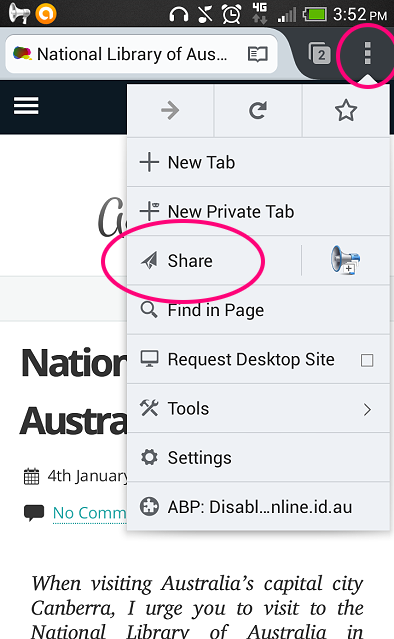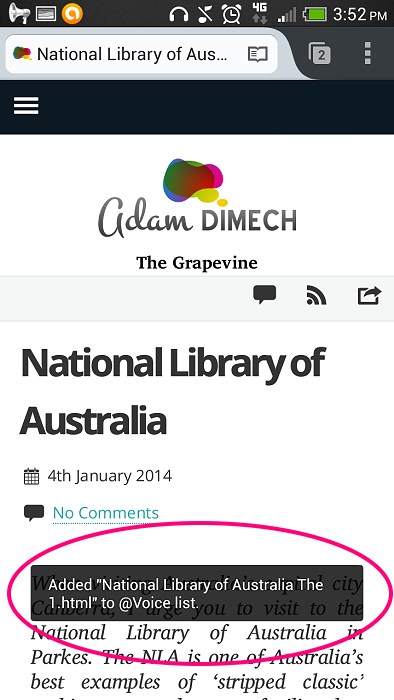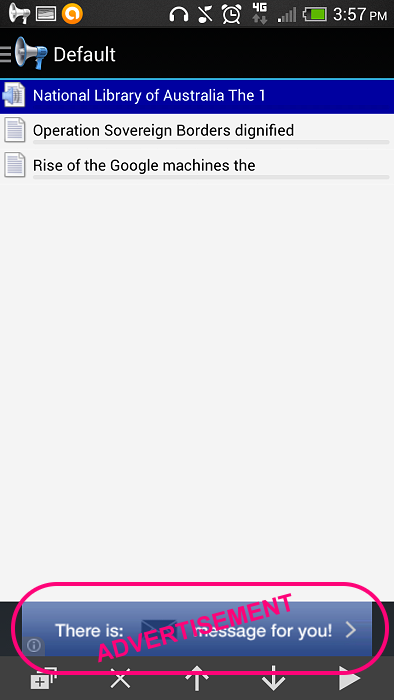In my line of work, I sometimes have cause to spend many hours performing routine work. To make the time pass, I like to listen to various podcasts as there’s poor radio reception in my workplace. It recently occurred to me that I’d also like to ‘listen’ to websites that contain long-form articles (such as blogs and newspapers), so I performed a search to locate some simple software that would enable this. I was rather surprised to discover that there isn’t any.
Many of us are aware that blind people use screen readers to navigate their way around the internet. Screen readers will read aloud the contents of screens so that the blind can use menus and navigate windows as well as utilise the internet. I assumed that software would available that will perform a similar function, but without the need to read menus and other unnecessary text?
As it turns out, there is. However it is fragmented. Presented below are the steps I used to set-up a system to enable my Android 4.2 device (an HTC One XL) to read aloud the contents of websites.
Step 1: Gather and Install Software
Firefox for Mobile
I have the Firefox Mobile web browser installed on my phone. If you do not have Firefox installed, I highly recommend it. You can download Firefox from Google Play. The rest of this tutorial will assume that you have a Firefox installation.
@Voice Aloud Reader
This is the software that will do the ‘reading aloud’. There are several alternatives (such as VoiceReading) but @Voice Aloud Reader works reasonably well, contains the right functionality and is free.
Download and install @Voice Aloud Reader from Google Play.
IVONA Text-to-Speech HQ
This programme will provide the ‘reading engine’ and platform for the voice. Android phones appear to come with a default reader via Google but for reasons that will become apparent later, I recommend this one.
Download and install IVONA Text-to-Speech HQ from Google Play.
IVONA Nicole AU English voice (Optional)
I am Australian and so I prefer to listen to an Australian accent. IVONA have an Australian voice – called “Nicole” – in beta development. During the beta period, “Nicole” is free. (Other accents are available for other nationalities, just search Google Play).
Download Nicole AU English voice from Google Play.
Be warned: This is a big download (145MB) so perform this task over wi-fi if your download credits are limited.
Step 2: Select the Voice
As mentioned above, I have selected the Nicole Australian English voice.
To add Nicole, open the @Voice Aloud Reader and select the “Change Voice or Language” button. (If the Default reading list is displayed, swipe to the right so that the below screen is displayed).

Choose the “Add language/voice” button within @Voice Aloud Reader
Under “Select the language in which the text should be read”, choose “English”.
Under “Next, choose an installed voice for this language…”, choose “IVONA HQ, Australia”.
Click on “Use Selected Voice“.
Note: You should not need to press “Add a language/voice. If you do press this, it’s acceptable for “Google Text-to-Speech Engine” to be listed as the TTS engine.
From now on, you should hear Nicole’s Australian voice.
Step 3: Customise the Voice
For me, Nicole’s default voice is not quite right. The rate, pitch and volume within @Voice Aloud Reader can be adjusted by moving the sliders at the bottom of the reading screen. There should be some default text in the window for Nicole to read. Press the ‘Play’ arrow and then adjust the sliders as desired.

Move the sliders to adjust voice pitch, rate and volume.
Note that this task can be performed at any time whilst reading is being performed, so if it’s too tricky now, you can come back to this step later.
Step 4: Read your first web pages
The @Voice Aloud Reader cannot read websites directly from the browser (although this would be nice). In order to read the web page, the text needs to be exported from the browser to the @Voice Aloud Reader. Thankfully in Android, this is relatively simple.
The @Voice Aloud Reader software will require some customisation. To enable this and to demonstrate how to get the @Voice Aloud Reader to work, I will select an article that I recently wrote on my personal blog about the National Library of Australia.
Open Firefox for Mobile, and enter the following URL into the address bar: http://blog.adonline.id.au/national-library-of-australia/
When the website has fully loaded (this is important), click on the menu ‘dots’ at the top right of the screen so that a menu drops down. Click on “Share” but do not click on the icon to the right of “Share”.

Click on the menu ‘dots’ in Firefox, then choose ‘Share’
A list of recipients for your shared item will be displayed. Choose “@Voice add to list“. Do not choose “@Voice aloud reader”.

Share the web page with “@Voice add to list”.
The browser should return to the website. If you look near the bottom of the page, you should briefly see a message indicating that the web page has been added to @Voice List.

The message confirming that the website has been queued in @Voice Aloud Reader
Leave Firefox and open @Voice Aloud Reader. If need-be, click on the menu beside the megaphone logo at the top-left of the reading screen to show the Default Reading List. The article should be listed there.
Return to Firefox and repeat the process with another two or three articles from other websites. After you receive notification that each website has been added to the list, you can continue adding more. You don’t need to keep returning to @Voice Aloud Reader each time.
When you have completed this task and compiled a list of sites to read, return to @Voice Aloud Reader. You should be able to see your articles listed in the Default Reading List. Do not click on the advertisement at the bottom!

The reading list in @Voice Aloud Reader
If you press the ‘Play’ arrow at the bottom, they should start being read aloud, in order. A bell will ring between each article.
Step 5: Correct pronunciation
One of the problems with Nicole is her pronunciation of certain words, phrases and acronyms. Some of these may be peculiar to Australia and so will need to be added so that they are pronounced correctly when reading. A good example is the acronym “NSW”, which will be read as en-ess-double-you when it really should be read as New South Wales. Another is “ACCC” which is read as ayee-see-see-see rather than ayee-triple-see.
To fix this and add other corrections, go to the @Voice Aloud Reader reading page, and click on the “Change Voice or Language” button and then “Edit speech“.
To correct a pronunciation, click on the ‘+‘ symbol at the top of the screen. Under “Pattern‘, choose the word or acronym to be targeted (eg: NSW). Under “replace“, write the correct pronunciation out phonetically (eg: new south wales). Press the speaker symbols on the right to compare and correct if you didn’t quite get it right the first time.
Click on “Save” when complete.
Here are some common mistakes that I have encountered that you may like to add:
- NSW becomes new south wales
- .com.au becomes dot com dot ay-yoo
- IPA becomes ie-pee-ay
- ACCC becomes ayee triple cee
- Nescafé becomes ness-café
- NDIS becomes en-dee-eye-ess
- selfie becomes selfi
- overhyped becomes over-hiped
- HMAS becomes aich-em-ay-ess
- bikie becomes bikee
Some of these are rather peculiar. For instance Nicole says “office” rather oddly, despite it being an obvious and common word.
As you encounter incorrect pronunciations, add corrections to your list. In time, the need for this will diminish.
Step 6: Delete items in reading list
Once you have completed listening to your articles, you will want to delete them. On the reading list screen, click on the “×” button and each entry will be deleted.
Step 7: Delete files
The @Voice Aloud Reader still stores the test from the pages that you read on your device. Removing them from the reading list does not delete them from the device.
To delete the files permanently, go to the Default Reading List and click on the ‘+‘ symbol at the bottom left of the screen. Click on the tick icon at the top left of the screen to tick all files (or you can choose manually) and then press the “×” logo to delete.
Press ‘Done‘ when complete.
Step 8: Some key settings
One irritating behaviour of @Voice Aloud Reader is its propensity for closing down when the ‘Stop’ button is pressed during reading.
To remedy this, click on the menu dots at the top right of the screen and then choose “Settings”, then “Speech Settings”. The following items should not be ticked:
- Start talking at once
- Speak text copied to clipboard
- Start talking when headset connected
The following items should be ticked:
- Start/Stop speech when wired headset key pressed
- Do not exit when the on-screen STOP button pressed
Some comments about this programme
The @Voice Aloud Reader is free (with advertisements), or a paid version can be purchased. The free version has the same functionality. This programme, whilst reasonably well developed, has some irritating behaviour.
Unlike the default media play in Android, @Voice Aloud Reader will not cease reading when the headphones are pulled-out. Nor is there a simple ‘pause’ button available when the phone is logged-out. Therefore, if an interruption occurs during listening, the choices are to either log back into the phone (after entering the security PIN), then navigating to the @Voice Aloud Reader and then pausing or just let it play and wind it back later. Pulling out the headphones sometimes triggers a pause, but not always.
I have also had the player start-up by accident when using the phone. Turning down the phone volume will not turn down @Voice Aloud Reader’s volume, so be warned. Fixing the default settings (as per Step 8) should minimise the risk of accidental playback but the volume problem needs to be addressed by the software vendor.
Finally, be warned that the combination of @Voice Aloud Reader and the IVONA packages can sometimes weigh heavily on device memory. On occasion, my phone has paused or there have been very brief moments of odd behaviour (such as all desktop icons having a white border around them). The phone certainly will function but it’s good to know that this can happen.
@Voice Aloud Reader seems intelligent enough to avoid reading image captions and comments on blog posts and news sites when valid HTML is used. It doesn’t seem to be able to bypass Twitter, Google and Facebook ‘like’ buttons, however. These will be read aloud.
Despite all of this, I do recommend this solution to having websites read.
Although technical in nature to set up, this solution is not too bad once implemented. I will assume that some of the bugs and memory problems will be ironed-out with later software releases. Whilst not especially intuitive, the combination of IVONA HQ and @Voice Aloud Reader should enable you to enjoy listening to most websites.

















